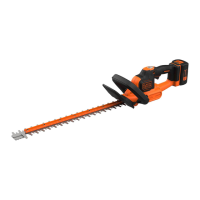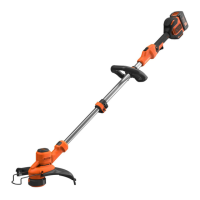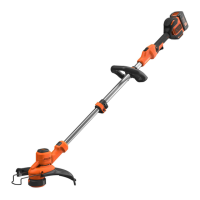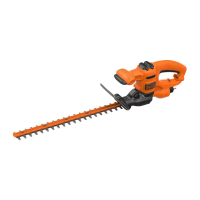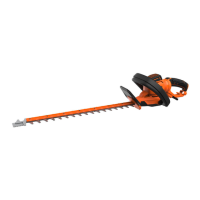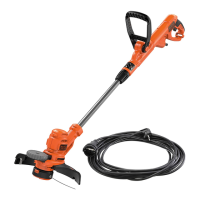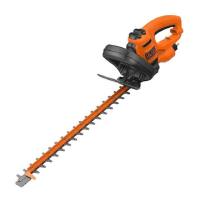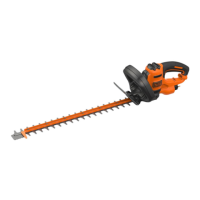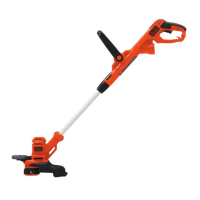21
ENGLISH
(Original instructions)
u When on a slope always stand on the uphill side of the
log. When “cutting through”, to maintain complete control
reduce the cutting pressure near the end of the cut without
relaxing your grip on the chain saw handles. Don’t let the
chain contact the ground. After completing the cut, wait
for the saw chain to stop before you move the chain saw.
Always stop the motor before moving from cut to cut.
Operation
Extended reach/Pole mode for trimming & pruning
Warning! Never stand directly under the limb you are cutting.
Always position yourself out of the path of falling debris.
u Never stand on a ladder (g. B19) or other unstable
support while using the Pole Saw. Always avoid any
position which can cause you to lose your balance and
cause severe injury.
u Keep other persons at least 15m from the work area.
Distractions can cause you to lose control (g. B20).
u Electrocution Hazard. To prevent shock, do not operate
within 15m of overhead electrical lines. Always check
surrounding area for hidden electrical lines (g. B21).
u Do not extend Pole Saw switch handle above shoulder
height.
Operating position (g. B22)
Always wear:
A. Head protection.
B. Eye protection.
C. Work gloves.
D. Strap.
E. Chainsaw trousers.
F. Steel toed shoes.
Warning! When pruning trees:
u Guard Against Kickback which can result in severe injury
or death. See “KICKBACK”, section to avoid the risk of
kickback.
u Do not overreach. Make sure your footing is rm. Keep
feet apart. Divide your weight evenly on both feet.
u Use both hands to grip Pole Saw as shown in gure B22.
Use a rm grip. Thumbs and ngers must wrap around
Pole Saw handle and pole.
u Never operate while in a tree, in any awkward position,
on a ladder or any other unstable surface. You may lose
control of the Pole Saw causing severe injury.
Trimming a tree (g. B23)
u Make sure Pole Saw is running at full speed before
making a cut. When starting a cut, place moving chain
against limb. Hold Pole Saw rmly in place to avoid
possible bouncing or skating (sideways movement) of the
Pole Saw.
u Make the rst cut 150mm away from tree trunk on
underside of a limb or branch. Use the top of the guide bar
to make this cut.
Guide the Pole Saw using light pressure to make a cut
that is 1/3 of the diameter of limb. Then make the nishing
cut from the top as shown in gure B23. Do not force
Pole Saw. The motor will overload and can burn out. It
will do the job better and safer at the rate for which it was
intended.
Note: If you try to cut off thick branches from the bottom, the
branch will close in and pinch the saw chain in the cut. If you
try to cut off thick branches from the top, without a shallow
undercut, the branch will splinter and pull bark from the tree.
u Remove Pole Saw from cut while it is running at full
speed. Stop Pole Saw by releasing ON/OFF switch. Make
sure chain has stopped before setting Pole Saw down.
Chain and bar
After every few hours of use, remove the sprocket cover,
guide bar and chain and clean thoroughly using a soft bristle
brush. Ensure oiling hole on bar is clear of debris. When
replacing dull chains with sharp chains it is good practice to
ip the chain bar from bottom to top.
Saw Chain Sharpening
Note: The cutters will dull immediately if they touch the ground
or a nail while cutting. To get the best possible performance
from your chain saw it is important to keep the teeth of the
chain sharp. Follow these helpful tips for proper saw chain
sharpening:
u For best results use a 4.5 mm le and a le holder or ling
guide to sharpen your chain. This will ensure you always
get the correct sharpening angles.
u Place the le holder at on the top plate and depth gauge
of the cutter.
u Figure B24- Keep the correct top plate (14a) ling angle
line of 30° on your le guide parallel with your chain (le at
60° from chain viewed from the side).
u Sharpen cutters on one side of the chain rst. File from
the inside of each cutter to the outside. Then turn your
saw around and repeat the processes for cutters on the
other side of the chain.
Note: Use a at le to le the tops of the rakers (portion of
chain link in front of the cutter) so they are about 0.635 mm
below the tips of the cutters as shown in gure B25.
u Figure B26 - Keep all cutter lengths equal.
u If damage is present on the chrome surface of the
top plates or side plates, le back until such damage
is removed.
Note: After ling, the cutter will be sharp, use extra caution
during this process.
Note: Each time the chain is sharpened, it loses some of the
low kickback qualities and extra caution should be used. It
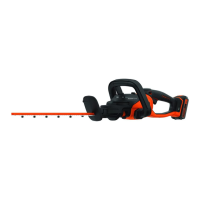
